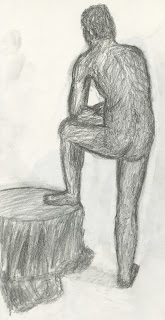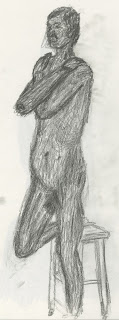Above are my three final images which I have drawn over Christmas break.
I started by drawing the glass and grapes on a quilt which I had set up, To draw these objects I used a scribbling type of technique where I would scribble a number of possible lines and then pick the one which I felt best matched the actual objects and then work on it. This technique wasn't time consuming, it gave me a simple sketch of the composition which I could then add more detail to. This drawing took around 40 minutes to complete, the main issues I came across whilst drawing was trying to make the grapes and quilt look realistic.
The second drawing I did is of a fountain with three angels on top, the fountain is in the "Churchill Memorial Park" in Jersey CI. For this drawing I used a very soft 6b pencil which I believe worked mainly to my advantage as it was much easier to draw the fountain due to the shades available, The one problem I found using it is that mistakes are much more difficult to put right as it is hard to erase if the line was too dark. To draw the image I used the angle at which the objects were facing or positioned and then drew multiple lines to first outline and then shade them in that given direction. By using this styles it makes it obvious to the viewer’s where the objects turn, curve and or separate. To draw the water I simply drew horizontal lines which are slightly wavy to try to show the ripples and then only slightly shaded some areas where less light was reflected.
The third and final drawing is of a statue of the devil and is found at "the devils hole" in Jersey CI, I believe that this is was a good example of a muscular person and although it is not exactly a life drawing the statue would have the same proportions as an actual person so we can easily relate to it. I found that drawing the main torso and legs of the statue was quite simple and straight forward as they contained a lot of budged and obvious muscles, the two main parts which I struggled on and still could not correct after various attempts were its face and right hand. I've also noticed that the balance of the model/statue in the drawing is slightly leaning backwards which would be an improbable standing position as he would simply fall over.































